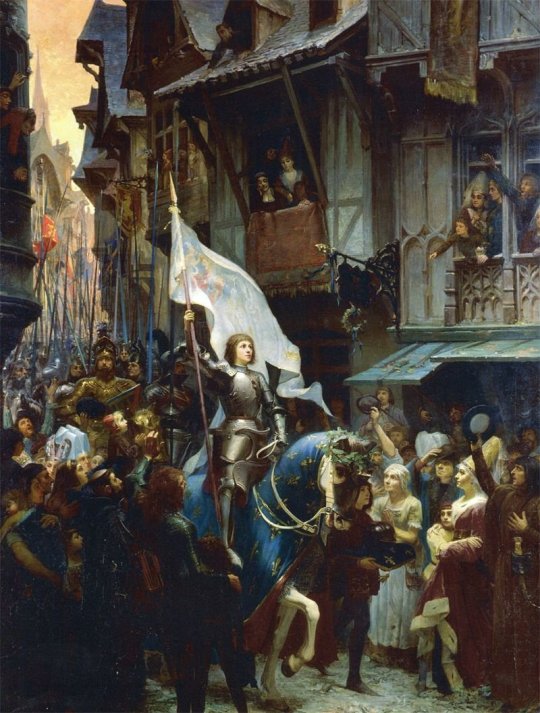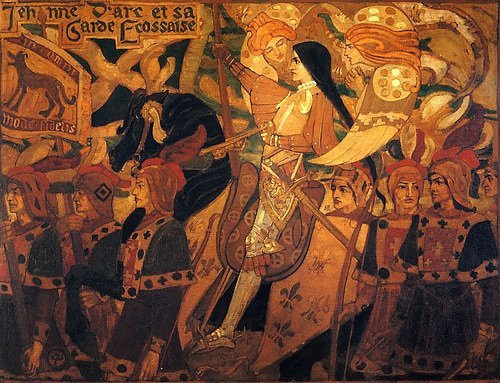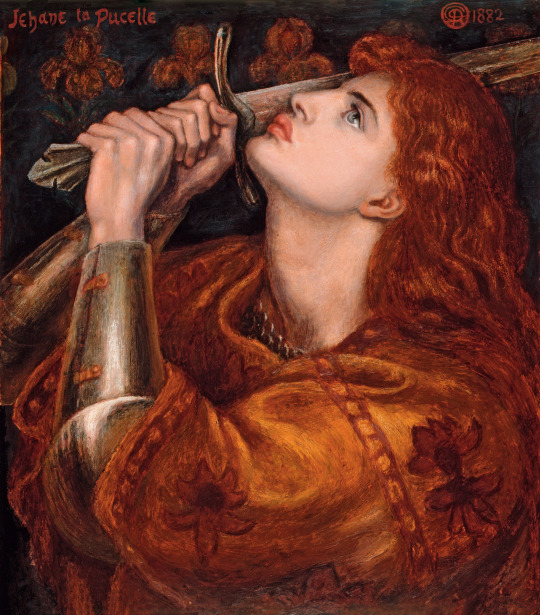#Jean-Jacques Scherrer
Explore tagged Tumblr posts
Text

"Entrée de Jeanne d'Arc à Orléans"
by Jean-Jacques Scherrer
Oil Painting, 1887.
Musée des Beaux-Arts d'Orléans.
HISTORY
Joan of Arc (one of the many spellings of her name) is one of France's patron saints and was honored for her role in the Siege of Orléans (1428-1429) during the Hundred Years' War (1337-1453).
She grew up as a peasant, her father being a farmer, but she had divine visions that she was visited and guided by archangel Micheal, Saint Margaret, and Saint Catherine. After having these sights, Joan acted accordingly, joining forces with the French by gaining respect for her piety and firmness, swaying Captain Robert de Baudricourt into her favor.
Long story short (definitely watch a video or read about her history instead of going off of my quick knowledge, in case you're interested and I miss certain facts... soz): Joan of Arc promised Dauphin Charles that he would be coronated at Reims if he allowed her to fight the English. Yeah... they were skeptical—mainly due to Joan being a 16-17-year-old woman at the time—so Charles had sacerdotal authorities interrogate her. After review, and considering the devastating turnout of Orléans (which has been under British siege), the clergy decided it'd be best for Charles to use the young woman as she's asking to be involved.
Assigned to join in taking back Orléans, Joan arrives with supplies on the 19th of April, 1429, alongside Commander Étienne de Vignolles (or *thank God for nicknames* La Hire). May 4th was when things started to pick up, the French launching an attack, which the saint almost missed due to napping (hey, I get it), and in the meantime, Joan sent out letters to the British, basically telling them to fuck off her land before a sword gets shoved up a not so divine place. On the 7th, Joan was WIA, but that didn't stop her from continuing her duty, and by the 8th, the British surrendered.
Joan of Arc is widely remembered as a woman who faced perseverance when it was uncommon for a woman combatant to exist, especially one who instantly rose to the top, fighting as a leader amongst male French commanders. Even burned at the stake by the English around the age of 19, Joan kept her faith, the same that got her onto the battlefield and was depicted proudly on the flag she waved. In 1920, she was finally recognized by the Roman Catholic Church and canonized by Pope Benedict XV as a patron saint for her home country. She's respected as a martyr and seen as a symbol of freedom, not only in a patriotic context but as a feminist (as she is hailed as one of the earliest feminists in middle-age history).

Again, I beg of you, if you are interested in learning more about the Siege of Orléans and/or Saint Joan of Arc, check out a video or pick up a book on the topic. I'm terrible at regurgitating historical information, especially when I haven't gotten any sleep. I'm not a historian, just a 19-year-old girl who likes to post art (ಠ_ಠ).
#art#oil painting#painting#history#artwork#french#french art#victorian#victorian art#joan of arc#feminism#hundred years war#middle ages#siege of orléans#battles#military#Jean-Jacques Scherrer#Musée des Beaux-Arts d'Orléans#french painting#victorian painting#19th century painting#19th century#saint#religious#religion#catholicism#patron saint#15th century
31 notes
·
View notes
Photo

Jean-Jacques Scherrer - Joan of Arc, victorious over the English, returns to Orleans and is acclaimed by the population, 1887.
14 notes
·
View notes
Text

Joan of Arc, victorious over the English, returns to Orleans and is acclaimed by the population, by French painter Jean-Jacques Scherrer (1887). Musée des Beaux-Arts d'Orléans.
7 notes
·
View notes
Text
On September 8th. Paris was attacked by Joan of Arc
38 Artists Embedded with Joan of Arc’s Military Campaign, With Footnotes Hermann Stilke (1803–1860)Central Part of The Life of Joan of Arc Triptych), c. 1843Oil on canvas135 × 146 cm (53.1 × 57.4 in)Hermitage Museum On this day in 1429, French heroine Joan of Arc, a peasant girl who believed she was acting under divine guidance, attempted to oust the duke of Burgundy and take Paris for newly…

View On WordPress
#Allan Davidson#Diogenes Maillart#Gaston Bussière#George Joy#Gillot Saint-Evre#Henryk Siemiradzki#Hermann Anton Stilke#Jean-Jacques Scherrer#Joan of Arc#Léon François Benouville#Paul de La Boulaye
0 notes
Text

The Matches. Jean Jacques Scherrer French 1855-1916. oil/canvas. http://hadrian6.tumblr.com
775 notes
·
View notes
Text


On April 29th 1429 Joan of Arc arrived to relieve the Siege of Orléans.
“The enemy of my enemy is my friend.” This ancient saying has been invoked many times throughout history, but one of the most successful examples of this logic was the Auld Alliance between France and Scotland.
Although the Auld Alliance was founded out of a mutual hatred of England in 1295, the French and the Scots grew closer over time. France sent significant aid to Scotland, particularly during their Second War of Independence against England. In return, Scotland reinforced the French army during the Hundred Years’ War.
It was during the latter days of the Hundred Years’ War that the French King created an elite personal bodyguard comprised of Scottish warriors called the Garde Écossaises(Scottish Guard).
Scottish forces served in the French military throughout most of the Hundred Years’ War, earning a reputation as capable fighters in the process. A Scottish force under John Stewart, Earl of Buchan, and Sir John Stewart of Darnley arrived in France in 1419 to great fanfare.
The Dauphin (heir apparent to the French throne) was in desperate need of help as his father, King Charles VI, suffered from a form of insanity and had few allies. For his own safety, the Dauphin picked out around 100 of the finest Scottish warriors to be his personal bodyguard, thus creating what would come to be known as the Garde Écossaise. In its early days, the Garde was primarily composed of archers, with some men-at-arms.
The Dauphin took further actions to secure Scottish loyalty. The Earl of Buchan was given land at Châtillon-sur-Indre, Stewart of Darnley was provided with land at Concressault and Aubigny, and several other Scottish leaders received land and castles, this was even before they even fought a battle on French soil!
However, that soon changed at the Battle of Baugé, as the French were still reeling from the Battle of Agincourt. The Scots’ performance at Baugé ended up leading to one of their most heroic victories.
Accounts of the battle vary by source, but it is clear that the English, under the Duke of Clarence, attempted to catch the Franco-Scottish force off guard. However, the Scots turned the tide of the battle by holding their ground at a bridge as the English tried to cross.
French forces soon reinforced them, leaving the English badly outnumbered as they had only brought part of their force for this assault. The English eventually forced their way across the bridge but were met and outflanked by the larger force. The Duke of Clarence was killed in the melee, and the English force was routed.
In return for their service, Scottish leaders were granted more lands. The Earl of Buchan was given the title Constable of France, essentially making him commander of the French armies. Unfortunately for the Scots, this success did not last.
The French-Scottish force suffered a crushing defeat at the Battle of Cravant during which Buchan was captured. The French forces fell back during an attempted river crossing, and the Scots were cut down as they stood alone against the English.
Buchan was exchanged but then killed during another disastrous defeat at the Battle of Verneuil after French troops once again retreated early in the battle and left the Scots to face the English alone.
However, the Garde Écossaise remained and continued to prove themselves throughout the Hundred Years’ War and beyond.
In 1429, a mere five years after the French-Scottish defeat at Cravant, Joan of Arc marched into Orléans to the sound of bagpipes. She entered the city accompanied by a guard of around 60 Scottish men-at-arms and 70 archers. The pipers played Hey Tuttie Tatie – the song that, legend has it, was played for Robert the Bruce as he marched into battle at Bannockburn.
In fact, Scottish soldiers made up a significant portion of the relief army as a whole in addition to Joan’s guard.
The pics are, Joan of Arc enters Orléans by Jean-Jacques Scherrer, 1887 and Jehanne d'Arc et sa Garde écossaise. Painting by John Duncan, Scottish symbolist painter.
12 notes
·
View notes
Text
My favorite Joan of Arcs
ok guys, so we all know Joan of Arc is an S-tier saint and historical figure. However, not all Joan of Arcs are depicted equally. Here are my favorite ones because she is an inspiration and an icon !

Joan of Arc by John Everett Millais
The sword, the armor, the red underneath it all... really nice composition. Her lower half being covered and obscured by the heavy red cloth brings to mind the flames consuming her at the stake, very evocative ! Not my favorite face, but eveyrhting else is impeccable.

Joan of Arc by Dante Gabriel Rossetti
Something about the pose is really captivating, the blade laid across her face with eyes raised,... I like the conservative color pallet here, again the use of warm colors especialy for her hair beings to mind the flames that kill her.

Joan of Arc enters Orléans by Jean-Jacques Scherrer
This one captures her presence and significance to the people of France really nicely. While I do like the more intimate, close up depictions of her that are more in line with traditional religious artwork, it is importatn to remember Joan of Arc as a figure of history as well. This piece depicts her arrival to Orleans, which would lead to the French defeating the English army in that area. It is triumphant and almost angelic, her face is lit brightly before a white banner that distinguishes her from the crowd of peasants and soldiers. Such a great work of art!

Joan of Arc by Albert Lynch
This one has almost more of a fantasy vibe to it, but I do love the white flowers that surround her amid the white banner and staff she holds. I always loved her face in this one too, despite the expression being relatviely unemotive it conveys a muted sense of conviction and certainty.
ANyways shes kind of my #goat and one of the my personal favorite and most fascinating historical figures, inspiring in every way !
14 notes
·
View notes
Text

{obikin is art}
"No, ah, need to mention this to, erm, Anakin, is there...?"
(Joan of Arc enters Orléans, Jean-Jacques Scherrer)
22 notes
·
View notes
Text

Joan of Arc entering Orleans (Entree de Jeanne d'Arc à Orléans) - Jean-Jacques Scherrer, 1887. (Musée des Beaux-Arts d'Orléans)
2 notes
·
View notes
Text
During the Hundred Years' War, 17-year-old peasant Joan of Arc led a French military force in relieving the city of Orleans, beleaguered by the English since October of the previous year. April 29, 1429.
Subscriber Content Add content here that will only be visible to your subscribers. Payment Image: Joan of Arc enters Orléans by Jean-Jacques Scherrer (1887, Musée des Beaux-Arts d’Orléans) On this day in history, April 29, 1429, during the Hundred Years’ War, 17-year-old peasant Joan of Arc led a French military force in relieving the city of Orleans, beleaguered by the English since October…

View On WordPress
0 notes
Photo

Jean-Jacques Scherrer - Joan of Arc leaving Vaucouleurs, February 23, 1429, 1887.
1 note
·
View note
Photo

The Departure of Jeanne d'Arc from Vaucouleurs by Jean-Jacques Scherrer (1887)
In a noble open space carpeted with grass on the high ground toward Vaucouleurs stood a most majestic beech tree with wide-reaching arms and a grand spread of shade, and by it a limpid spring of cold water; and on summer days the children went there—oh, every summer for more than five hundred years—went there and sang and danced around the tree for hours together, refreshing themselves at the spring from time to time, and it was most lovely and enjoyable. Also they made wreaths of flowers and hung them upon the tree and about the spring to please the fairies that lived there; for they liked that, being idle innocent little creatures, as all fairies are, and fond of anything delicate and pretty like wild flowers put together in that way. And in return for this attention the fairies did any friendly thing they could for the children, such as keeping the spring always full and clear and cold, and driving away serpents and insects that sting; and so there was never any unkindness between the fairies and the children during more than five hundred years—tradition said a thousand—but only the warmest affection and the most perfect trust and confidence; and whenever a child died the fairies mourned just as that child’s playmates did, and the sign of it was there to see; for before the dawn on the day of the funeral they hung a little immortelle over the place where that child was used to sit under the tree. I know this to be true by my own eyes; it is not hearsay. And the reason it was known that the fairies did it was this—that it was made all of black flowers of a sort not known in France anywhere.
—Mark Twain, Personal Recollections of Joan of Arc
3 notes
·
View notes
Text

On September 8th. Paris was attacked by Joan of Arc
38 Artists Embedded with Joan of Arc's Military Campaign, With Footnotes
On this day in 1429, French heroine Joan of Arc, a peasant girl who believed she was acting under divine guidance, attempted to oust the duke of Burgundy and take Paris for newly crowned King Charles VII…
Please follow link for full post
Jean-Jacques Scherrer,Gillot Saint-Evre,Léon François Benouville,Joan of Arc,Paul de La Boulaye,George Joy,Gaston Bussière,Allan Davidson,Hermann Anton Stilke,Henryk Siemiradzki,Diogenes Maillart,
On September 8th. Paris was attacked by Joan of Arc
#Icon#Bible#biography#History#Jesus#mythology#Paintings#religionart#Saints#Zaidan#footnote#fineart#Calvary#Christ#warrior
1 note
·
View note
Photo

Jean-Jacques Scherrer - Entrée de Jeanne d'Arc à Orléans (1887) Musée des Beaux-Arts, Orléans
#jean-jacques scherrer#scherrer#joan of arc#jeanne d'arc#orleans#oil on canvas#one thousand ophelias#french painter
126 notes
·
View notes
Text

Joan of Arc Leaving Vaucouleurs by Jean Jacques Scherrer
#joan of arc#jeanne d'arc#art#painting#history#europe#european#france#french#knights#knight#medieval#middle ages#castle#jean jacques scherrer#armour
31 notes
·
View notes
Photo

Elle France September 9, 1968, photographed by David Bailey.
#david bailey#elle france#jacques heim#jean-louis scherrer#vintage fashion#fashion#1960s fashon#1968#my scan#*
31 notes
·
View notes